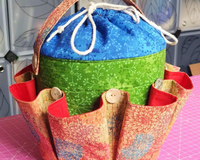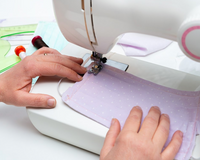HOW TO UNDERSTAND THE INFORMATION ON THE BALL BAND LABEL INON YOUR YARN & WOOL
The ball band on your yarn / wool is a really a important guide with information about your wool, how to knit with it and how to clean your finished garments.

Meterage / Yardage
Every ball of yarn band should display how many meters and / or yards there are in that ball of wool. This information is particularly important if you are not using the exact wool that the pattern suggests, as different brands of yarn have different meterage / yardage amounts. You should always look at the meterage / yardage needed on a pattern rather the number of balls or weight of the yarn.
On the photograph (above) the approximate lengths on this ball of yarn are 200m / 218 yards, this is is our Robin Bonny Babe Aran weight yarn. If you are using a pattern for this yarn, then it is perfectly okay to use the number of balls suggested. If, however, your pattern is for a different aran weight yarn, the meterage / yardage could state 8 balls that contain 220m / 241yds - so 8 balls of our Robin Bonny Babe Aran would not be enough to complete your garment.
e.g. 8 balls @ 200m = 1600 m whereas 8 balls x @ 220m = 1760m
……. so you would need 9 balls not 8 balls to give you enough meterage / yardage to complete your project.
Knitting Gauge
Most of the major yarn manufacturers provide this information on the ball band. It is usually shown as a grid box of 10cm x 10cm with rows on the right hand side and stitch count across the top - as with our ball band photograph above.
It is particularly important to find out if you ‘knit to gauge’ when knitting garments as it could mean the garment is too big or too small. Using this information you can see if you are a tight or loose knitter.
Knitting a tension square.
It is always a good idea to knit a tension square - it is not a waste of time! It is not a difficult thing to do but it will become the foundation of your item and could save a lot of heartache at the end of your project. If you do not knit to tension you could run out of yarn or produce a garment that does not fit well. I would always suggest knitting a tension square, especially if you are not using the intended wool for the pattern or are new to knitting. If your project has two or more designs you may need to knit a tension square for each design.
Items you will need are: the yarn you will be using for your knitting project, the knitting needles you will be using as suggested on the ball band, a ruler (not a tape measure) and pins.
It is a good idea to knit a tension square larger than the grid shown on the ball band. For instance, on the ball band in our photograph it suggests casting on 19 stitches and completing 24 rows to form a square which should measure 10cm x 10cm. If you knit it slightly wider than the suggested 19 stitches, and by leaving extra knitting at either side, it will make it easier to measure once off the knitting needles as it has a tendency to curl up. Cast off loosely.
Do not iron your tension square and definitely never steam press your knitting as this can ruin the structure of the yarn - leaving it limp and the design flattened. It is advisable to block your tension square by pining out onto a towel or foam blocking mat, using pins, being careful not to stretch the knitting. Spray with cold water and leave to dry. Once dry you are ready to measure your tension square - this needs to be done in good light and on a level surface. Using a solid ruler - not a tape measure as they tend to move about - count how many stitches there are across 10cm and how many rows there are, again down 10cm. If you knit to tension then the stitches and rows should equal the grid on your ball band - so our ball band states 19 stitches to 24 rows to form a 10 cm square.
Correcting your tension
If your tension square equals the tension given on the ball ball - then fantastic - you knit to tension and you can continue with your project.
Even if there is even a slight difference from the number of stitches to the measurement , it must be rectified. If there are fewer stitches than recommended, it means you are a loose knitter and the finished item will be too large. If you want to continue using your current wool then you will need to change to smaller needles. If you have used 4.5mm needles try moving down to a size 4mm and knit another tension square.
If your tension square has more stitches than the ball band states - you are a tight knitter and your project will be too small. You will need to use larger needles - so for the wool used used in our photograph try moving up to a size 5mm needle and knit another tensions square.
Donna




